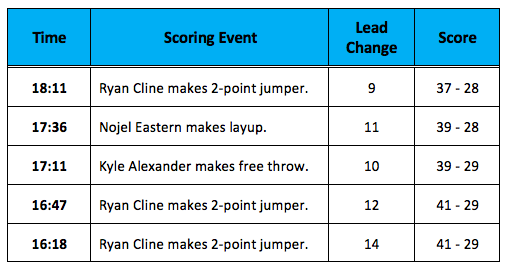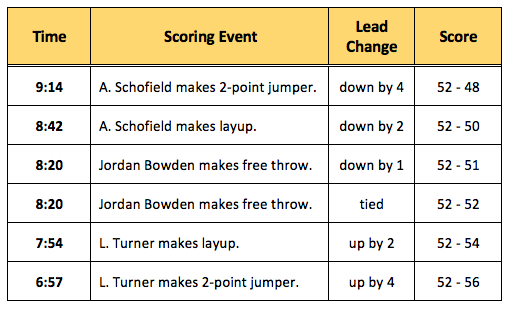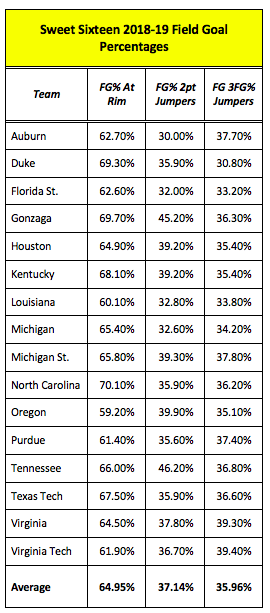In the run-up to this season’s Final Four we were greeted by two interesting but unsurprising commentaries. Unsurprising because they merely confirmed what we already knew: that the number of 3-point attempts in college basketball continues to surge, and correspondingly, the number of dunks has followed suit.
In his April 8th Sports Illustrated piece, citing data compiled by Ken Pomeroy, Andy Staples recounted the record number of treys attempted in the tournament. Back in 2014 and ‘15 the percent of three-point field goal attempts per tournament game hovered around 32% but rose to 35% in 2016, then cleared 38% last season. Through the first 64 games of this year’s tournament, Pomeroy found that the average percent of three-point attempts had grown to nearly 41%.
Hoop Vision’s Jordan Sperber chimed in with a nifty chart, illustrating the trend over a ten-year period.

And what does the dramatic uptick in three-point attempts have to do with the increasing number of dunks generated in this year’s tourney?
Josh Plano’s March 28, 2019 piece at FiveThirtyEight.com revealed that six of this year’s Sweet 16 entries had a dunk share, or percent of 2-point attempts, exceeding 10%. Four years ago, only one did. “This is less about a few dunk-crazed teams and more a reflection of the nationwide trend in college basketball,” reported Plano. On the eve of the Final Four, the season had produced 19,550 dunks, about 2,000 more than just five years ago.
And the reasons?
“We’re seeing more dunks,” ESPN analyst Jay Bilas told The New York Times, “because there are more spectacular athletes out there.” More significantly, though, Bilas cited the symbiotic relationship between 3-pointers and dunks.
The rise of the three as a strategic weapon has created an either-or game: you shoot the three or drive to the rim for a high percentage layup or dunk. You avoid all other lower percentage 2-point attempts. Throw in the long-range accuracy of a Carson Edwards or Kyle Guy and the crazy athleticism of players like Zion Williamson and Ja Morant, and you end up with lots of threes and dunks.
Again, interesting but not really surprising.
While the three-pointer has greatly influenced offensive schemes and strategy, I sometimes wonder if the media echo chamber has overly dramatized its importance, imbuing it with near magical qualities when its actual benefits are, in many ways, quite relative.
Here’s an interesting experiment.
Take any given college game and convert its 3-point field goals to their pre-1986 value of two. In other words, pretend the three-point arc doesn’t exist. Treat every field goal the same. No matter where you are on the floor, you get two points for every shot you make.
What happens to the outcome of the game? Does the winner remain the winner and the loser, the loser, or do they swap places?
On the heels of this season’s NCAA tourney I ran this experiment using the fifteen games that comprised the tournament’s Sweet Sixteen, Elite Eight, and Final Four. Keep in mind that the participants were largely the top of the heap – fourteen of the tournament’s first sixteen seeds, the only outliers a 5thand 12thseed.
Guess what? The winners and losers stayed the same. Not a single winner was determined by its ability to shoot the three. The only thing that changed was the margin of victory.

In nine contests, the margin fell; in one it stayed the same; and interestingly, in five games it actually increased.
So, how important are 3-pointers to success?
It’s relative to the moment.
In the “good old days” you needed five unanswered baskets to recover from a ten-point deficit. Now you only need four because “three counts more than two,” but this numeric reality cuts both ways — it’s relative.
Just as one team benefits from using the three to build its lead, the comeback team benefits from using the three in knocking down the lead. Today’s lead may be “wider” or “bigger” than in the past because “three counts more than two” but the same dynamics work in reverse. The team attempting to come back can use a combination of twos and threes just as their opponent used twos and threes to build the lead in the first place.
It’s a zero-sum game… a closed system. Regardless of the relative value of each field goal, basketball is still a matter of generating, or conversely, denying offensive possessions and shot attempts.
In today’s game if I’m down by nine I only need to make three long-range jumpers to make up the difference so I have an important option, especially if the clock is running down… an option I didn’t have before 1986. In the pre-three era a team might run off four baskets to build an eight-point lead and their opponent knew it needed four possessions to get back in the game. Today, in the same amount of time, a team might run off four 3-pointers to build a 12-point lead but its opponent still needs only four possessions to get back in the game. Nothing’s really changed. The number of required shot attempts is the same in both eras.
For example, Team Blue goes on a run: a dunk, a three, a steal and another dunk, another three, and very suddenly, a tie game becomes a 10-point lead. For the next five minutes the two teams go back and forth trading points and it’s still a 10-point gap. Then, Team Red goes on a tear with three quick three pointers… and now they’re only a point behind.
How is this substantively different than a game in 1980 unfolding in the same manner but with field goals worth only two points? In today’s game the initial run creates a “larger” gap leading to the second run of threes that cuts the gap to one point while the 1980 scenario features a “smaller” gap followed by second run of twos that cuts the gap to two points. In both cases the comeback team still needs one more possession to close the gap.
The only difference between “now” and “then” is the hype created by the echo chamber of 24-7 television and internet coverage. One scenario involves a flurry of long-range “threes” with lots of hype while the other involves a flurry of “boring twos” and little media attention because “back then” games were generally televised regionally instead of nationally or, very often, not broadcast at all.
Still not convinced? Let’s try another perspective.
Basketball games are generally won in short spurts — specific inflection points where one team “finds itself” and goes on a run, capitalizing on a hot hand or its opponent’s sudden lapse or breakdown. In a game of fast tempo, the explosion may result in a run of 8 to 15 points or more. In a slower game, 4 to 8 points. In either case, the team that exploits these short-lived spurts is usually the winner.
You can identify these spurts in the play-by-play logs kept by each game’s army of statisticians. The logs document the flow of the game, describing each specific event in time sequence.
Here’s an excerpt from Purdue’s Sweet Sixteen game against Tennessee. It picks up at the 18:11 mark in the second half with Purdue leading Tennessee by 10 points, 42 – 32.

Over the next 2 minutes and 7 seconds, beginning with a Ryan Cline jumper, Purdue runs off four unanswered baskets to Tennessee’s single free throw. Two 2-point jumpers, one 3-pointer and a layup, and the lead dramatically climbs to 18 points.
But what happens when we convert all the field goals in this game to their pre-1986 value of two points? What happens to the game log?

First, because we’ve converted all of the game’s 3-pointers to 2-pointers, the score before Cline makes his first jumper is 35 – 28, Purdue enjoying a 7-point lead. Then Cline goes on a tear and with his last jumper at the 16:18 mark, Purdue’s lead has grown to 14.
In the first illustration Purdue increased a lead of 10 points to 18, a net pick-up of 8. In the second illustration where 3-pointers have been converted to two points, Purdue’s lead of 7 swells to 14, a net pick-up of 7 points.
What’s the qualitative or substantive difference between 8 and 7? The run or inflection point that brings the crowd to its feet during Ryan Cline’s two minutes of shooting theatrics is the same.
Let’s move to later in the game when Tennessee responds with its own run, dramatically shrinking Purdue’s lead as the clock winds down.
With 9:14 left in regulation, down by 12, Tennessee’s Admiral Schofield makes a 3-point jumper to trigger the Volunteer run. In a brief 2 minutes, 17 seconds, Tennessee runs off four field goals and two free throws to tie the game. Here’s the play-by-play log charting the run:

Now, let’s replay the spurt, this time converting all of the game’s 3-pointers to their traditional two-point value.

The first thing to note is that the Purdue lead preceding theTennessee run is only 6 points, 52 – 46, not 12 as depicted in the actual game log. Schofield’s first jumper, now worth only 2 points, cuts the margin to 4. Instead of running off 12 consecutive unanswered points to tie the game, Tennessee outscores Purdue by 10 points to take a 4- point lead. An interesting turn of events!
But again, it’s all relative.
In the 3-point scenario, Tennessee quickly erases a 12-point deficit to the tie the game; in the 2-point scenario, they quickly tie the game, then sprint ahead to a 4-point lead. In both cases, the importance of the particular field goal value – a three or a two – is relative to the moment. Though television tends to magnify the impact of the 3-pointer, every game’s inflection points occur regardless of the value of a field goal.
Making a flurry of long-range threes is not inherently, or necessarily, any more exciting or indicative of better basketball than a flurry of 2-pointers.
Here’s a short highlight clip of Aaron Henry, Michigan State’s terrific freshman, torching the LSU defense in this year’s Sweet Sixteen contest with a series of five, off-the-bounce jumpers inside the 3-point arc.
Are these 2-point, midrange pull-ups less exciting, impactful, graceful, or skilled than some kid’s uncontested 3-pointer from the deep corner?
So, if it’s all relative, what’s the real significance of the three and its increasing use in today’s college game?
In a word… spacing.
Because the 3-pointer rewards shooters with an extra point, it’s encouraged several generations of players to attempt an ever-greater proportion of their shots from beyond the arc and their coaches to employ offensive schemes that generate such shots. In the process, players and coaches have rediscovered the central axiom of modern basketball: proficient jump shooting stretches defenses.
The emergence of the jump shot in the late 1940’s followed by its rapid adoption across the country in the 1950’s made the gamevertical, liberating the offensive player to maneuver on his own. The jump shooter’s quick release combined with the height attained made it necessary for the defensive player to play much tighter than what was previously needed. The defender’s aggressiveness made him vulnerable to the fake and drive and, in particular, to a brand-new maneuver — the lethal pull-up jumper. No longer would teams have to rely on intricate passing and patterned movement to free a shooter long enough to attempt a two-handed or one-handed set shot. Now players could catch and shoot while moving. Quickness became a player’s greatest asset.
You don’t need the 3-pointer to create spacing. You need proficient jump shooters. A good shooter with long range proficiency will create space regardless of the value of the shot. The longer his range, the greater space he creates. This is true whether field goals are worth three points or two.
When an offense spreads the floor with capable shooters, it necessarily stretches the defense, creating gaps for driving and penetration. But a poor jump shooting team, no matter how it attempts to spread the floor, and regardless whether shots are worth 3 or 2, will not pull defenders to the perimeter. Instead, they will sag and choke off paths to the basket.
Today, we’ve reached a point where for many teams, their 3-point proficiency matches or even exceeds their 2-point proficiency. Here’s another look at this year’s Sweet Sixteen teams comparing their shooting percentages at three distances.

Nine of the teams actually enjoyed better shooting percentages from beyond the arc than inside it. The only outlier was Duke who, to paraphrase ESPN’s Seth Greenberg, struggled throughout the tournament and ultimately lost because they were not just a poor 3-point shooting team, they were a poor jump shooting team, in general.
Even if we eliminated the 3-pointer tomorrow I don’t think coaches would stop spreading the floor as they’ve re-learned the value of spacing. You have to defend good shooters wherever they are. Would you stop guarding a Kyle Guy, Ty Jerome, Davide Moretti, or Ryan Cline who all shoot more than 40% from beyond the arc if such shots were suddenly worth only two points?
Last week the NCAA Rules Oversight Panel voted to extend the men’s 3-point arc from its current 20 feet, 9-inch distance to the international distance of 22 feet, 1¾ inches. It will be interesting to see if the extension makes a substantive difference in the current dynamics of the game.
Will the longer distance curb the growth of 3-point attempts as the committee hopes? If the extension pulls defenders farther from the basket, will the increased operating space lead to greater variety in offensive style and strategy? Will players who lack the longer-range proficiency required by the new line rediscover the value of the pull-up, midrange jumper?
We’ll have to wait and see.

thanks Mark—interesting stats on the 3 pointer.
Never liked the 3 pointer until the Splash brothers came on the scene.
Golden State uses their long range shooting to score and their shooting success
opens up passing lanes that they take advantage of. College teams aren’t
together long enough to really take advantage of the “open floor”
Too many teams lose players leaving for the pros too early.
Which leads me to my next non-sequitur comment which is much praise has come John Belein’s way for the job he did at Michigan and overall, he did move
the program to a better place BUT I’m still trying to figure out why some of his
players leave too early. That came into focus again this year when Poole and Bradzekis left after average performances. Very frustrating for a Michigan fan who watched Mich State beat us up with better players who will be back in college next year. Other Belein players from previous years have also left too early. The most notable example is Glenn Robinson who, had he stayed for his junior year, would have been the focal point of the offense, but went pro and never developed his offensive game. From the same team, a guy named McCurrey (sp?) made the same mistake under different circumstances.
Did they all dislike playing for Belein? Izzo yells at his players but they seem to like him
Thanks for reading the post and commenting on it. Love the Warriors open floor style of play. Interesting, that they generally favor passing and cutting, and running off-ball screens that require players to move without the ball as opposed to the almost constant ball-screens employed by everyone else in the league… and over the last two or three seasons they shoot more midrange jumpers than most NBA teams. Kerr does not seem obsessed with the analytic purity of the 3-pointer. Regards your thoughts on Michigan and John Belein? I don’t have a clue. But you’re right about Izzo. His kids always play hard and get better as the season moves forward.
Mark – good read as always. Did you see any stats from the shot selection from the opposing teams during their opponent’s hot streak of hitting a few threes? I’m always leary of teams falling away from their game plan and trying to match 3pt shot for shot, therefore taking low percentage shots. Two or three made threes by their opponent is “countered” with two or three missed three’s. Just gave up three possessions. In your examples, do you know what Tennessee and Purdue were doing offensively when the other team was on a spurt?
Pat, thanks so much for reading and commenting on my stuff! My general impression is the same as yours: too often teams panic and try to respond to a flurry of three pointers with a flurry of their own. Instead of following a game plan and chipping away at their opponent’s lead they go for all the marbles and fall farther behind. In the two play-by-play illustrations I presented, each featured one team scoring unanswered points during a two-minute spurt. In one of the illustrations there was a single free-throw made by the other team. So, basically, both flurries were one-sided. Here’s a link to the play-by-play for the entire Purdue-Tennessee game: https://www.espn.com/mens-college-basketball/playbyplay?gameId=401123382. You may find an example of what you suspect often happens.